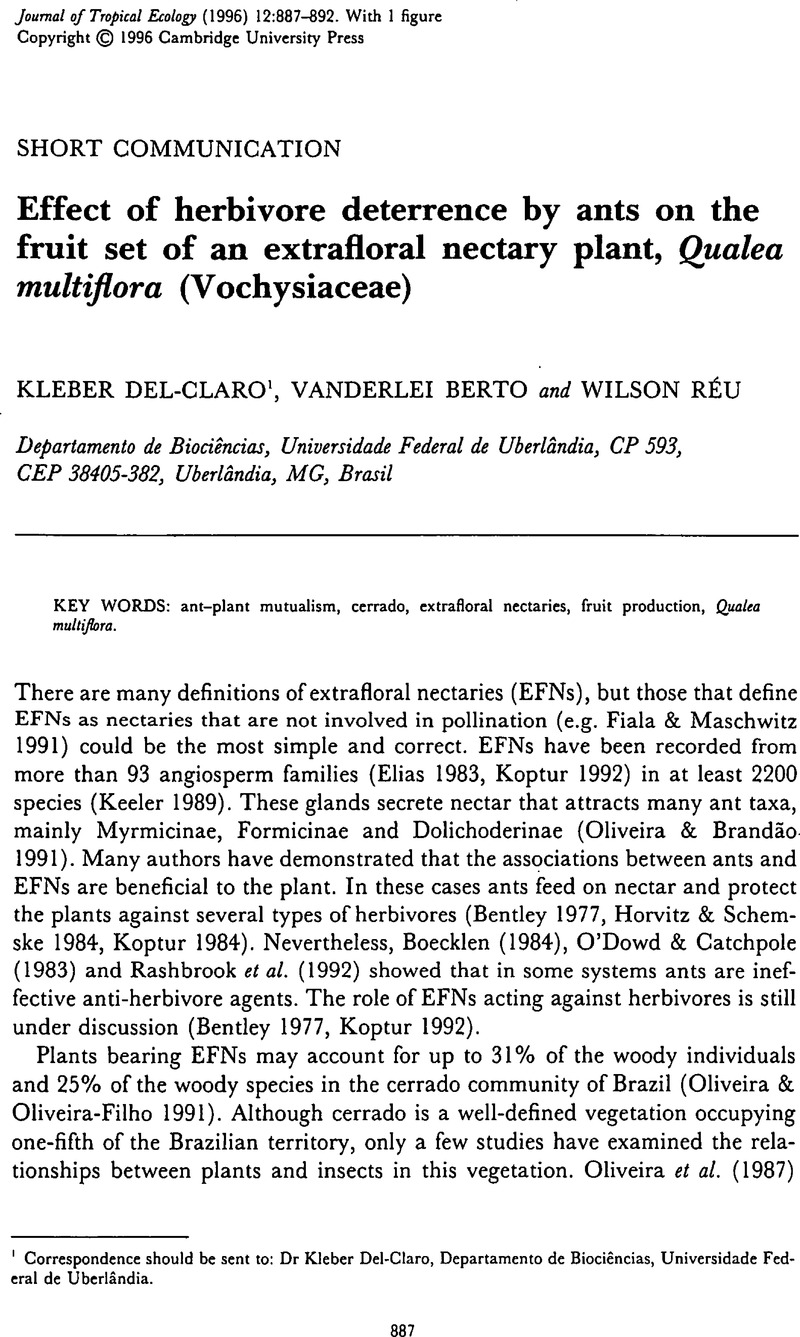Crossref Citations
This article has been cited by the following publications. This list is generated based on data provided by Crossref.
Willmer, P. G.
and
Stone, G. N.
1997.
How aggressive ant-guards assist seed-set in Acacia flowers.
Nature,
Vol. 388,
Issue. 6638,
p.
165.
Oliveira, Paulo S.
and
Pie, Marcio R.
1998.
Interaction between ants and plants bearing extrafloral nectaries in cerrado vegetation.
Anais da Sociedade Entomológica do Brasil,
Vol. 27,
Issue. 2,
p.
161.
Oliveira, P. S.
Rico‐Gray, V.
and
Castillo‐Guevara, C. Díaz‐Castelazo† and C.
1999.
Interaction between ants, extrafloral nectaries and insect herbivores in Neotropical coastal sand dunes: herbivore deterrence by visiting ants increases fruit set inOpuntia stricta(Cactaceae).
Functional Ecology,
Vol. 13,
Issue. 5,
p.
623.
Fernandes, G. W.
Fagundes, M.
Woodman, R. L.
and
Price, P. W.
1999.
Ant effects on three‐trophic level interactions: plant, galls, and parasitoids.
Ecological Entomology,
Vol. 24,
Issue. 4,
p.
411.
Freitas, Leandro
Galetto, Leonardo
Bernardello, Gabriel
and
Paoli, Adelita A.S.
2000.
Ant exclusion and reproduction of Croton sarcopetalus (Euphorbiaceae).
Flora,
Vol. 195,
Issue. 4,
p.
398.
Paiva, Élder Antônio Sousa e
Morais, Helena Castanheira de
Isaias, Rosy Mary dos Santos
Rocha, Dulce Maria Sucena da
and
Oliveira, Paulo Eugênio
2001.
Occurrence and structure of extrafloral nectariesin Pterodon pubescens Benth. and Pterodon polygalaeflorus Benth..
Pesquisa Agropecuária Brasileira,
Vol. 36,
Issue. 2,
p.
219.
ROMERO, G. Q.
2002.
Protection of Vochysia elliptica (Vochysiaceae) by a nectar-thieving ant.
Brazilian Journal of Biology,
Vol. 62,
Issue. 2,
p.
371.
Ortiz, P. L.
Arista, M.
Oliveira, P. E.
and
Talavera, S.
2003.
Pattern of Flower and Fruit Production in Stryphnodendron adstringens, an Andromonoecious Legume Tree of Central Brazil.
Plant Biology,
Vol. 5,
Issue. 6,
p.
592.
Heil, Martin
and
McKey, Doyle
2003.
Protective Ant-Plant Interactions as Model Systems in Ecological and Evolutionary Research.
Annual Review of Ecology, Evolution, and Systematics,
Vol. 34,
Issue. 1,
p.
425.
Perry, John R.
2003.
Review: The History of Iran
Elton L. Daniel.
Journal of Islamic Studies,
Vol. 14,
Issue. 1,
p.
84.
KATAYAMA, Noboru
and
SUZUKI, Nobuhiko
2004.
Role of extrafloral nectaries of Vicia faba in attraction of ants and herbivore exclusion by ants.
Entomological Science,
Vol. 7,
Issue. 2,
p.
119.
Romero, Gustavo Q.
and
Vasconcellos-Neto, João
2004.
BENEFICIAL EFFECTS OF FLOWER-DWELLING PREDATORS ON THEIR HOST PLANT.
Ecology,
Vol. 85,
Issue. 2,
p.
446.
Oliveira, Paulo S.
and
Freitas, André V. L.
2004.
Ant–plant–herbivore interactions in the neotropical cerrado savanna.
Naturwissenschaften,
Vol. 91,
Issue. 12,
p.
557.
Tillberg, Chadwick V.
2004.
Friend or foe? A behavioral and stable isotopic investigation of an ant–plant symbiosis.
Oecologia,
Vol. 140,
Issue. 3,
p.
506.
Katayama, Noboru
and
Suzuki, Nobuhiko
2005.
The importance of the encounter rate between ants and herbivores and of ant aggressiveness against herbivores in herbivore exclusion by ants on Vicia angustifolia L. (Leguminosae) with extrafloral nectaries.
Applied Entomology and Zoology,
Vol. 40,
Issue. 1,
p.
69.
Koptur, Suzanne
2005.
Plant-Provided Food for Carnivorous Insects.
p.
75.
GUIMARÃES, PAULO R.
RAIMUNDO, RAFAEL L. G.
BOTTCHER, CLÁUDIA
SILVA, ROGÉRIO R.
and
TRIGO, JOSÉ R.
2006.
Extrafloral nectaries as a deterrent mechanism against seed predators in the chemically protected weed Crotalaria pallida (Leguminosae).
Austral Ecology,
Vol. 31,
Issue. 6,
p.
776.
Korndörfer, Ana Paula
and
Del‐Claro, Kleber
2006.
Ant Defense Versus Induced Defense in Lafoensia pacari (Lythraceae), a Myrmecophilous Tree of the Brazilian Cerrado1.
Biotropica,
Vol. 38,
Issue. 6,
p.
786.
AGARWAL, VIVEK MOHAN
and
RASTOGI, NEELKAMAL
2008.
Role of floral repellents in the regulation of flower visits of extrafloral nectary‐visiting ants in an Indian crop plant.
Ecological Entomology,
Vol. 33,
Issue. 1,
p.
59.
Machado, S. R.
Morellato, L. P. C.
Sajo, M. G.
and
Oliveira, P. S.
2008.
Morphological patterns of extrafloral nectaries in woody plant species of the Braziliancerrado.
Plant Biology,
Vol. 10,
Issue. 5,
p.
660.



